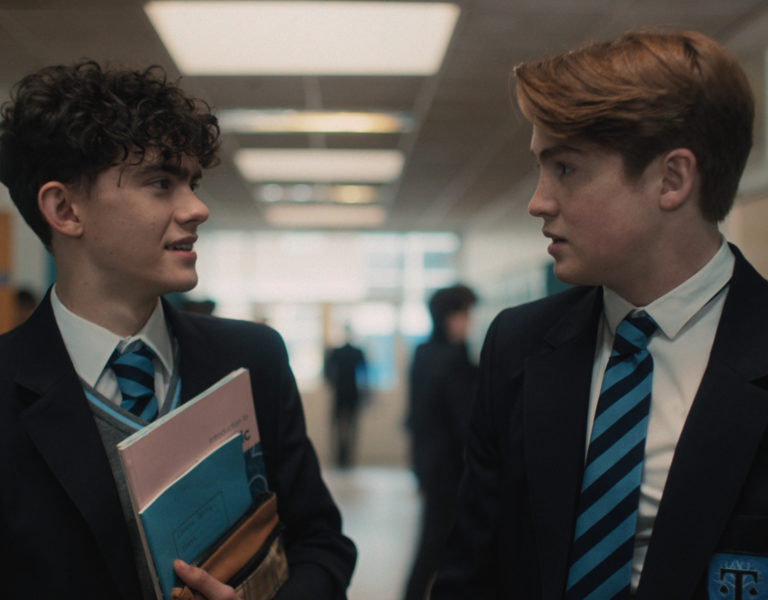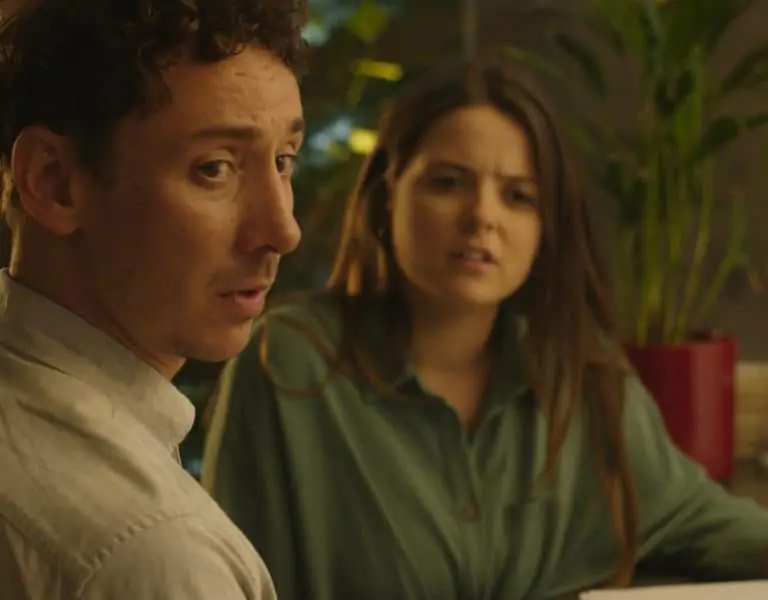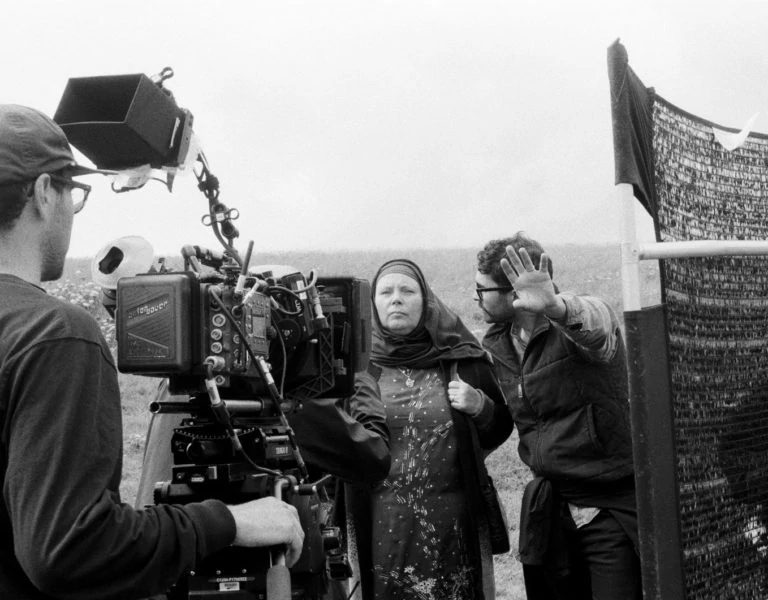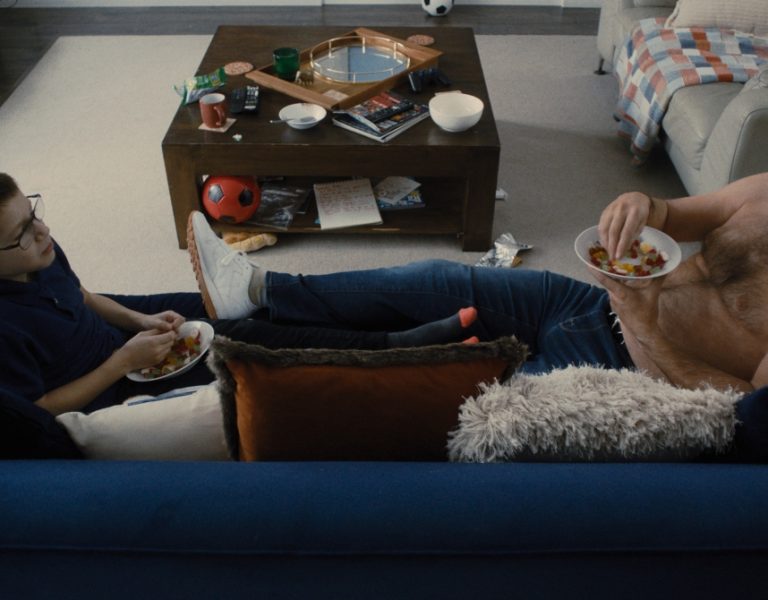Cutting-edge creativity
Netflix’s UK Documentary Talent Fund will return for its second year to seek out a new generation of documentary storytelling stars. One of the inaugural programme’s winning projects, Love Languages, has been longlisted for the 2023 BAFTAs. Find out more about the project, centred around an Afro-Caribbean barbershop, from cinematographer Olan Collardy.
Love Languages paints six intimate portraits of Black British men as they share their personal experiences of love and loss in their safe space, an Afro-Caribbean barbershop. The short documentary’s director Jason Osborne and producer Precious Mahaga were part of the winning 2021 cohort, impressing with their take on the brief: “Britain’s Not Boring And Here’s a Story.” The winners received financing of up to £40,000 for their film and could benefit from a mentorship programme supported by Netflix and WDW Entertainment.
Cinematographer Olan Collardy lensed the final documentary, which can be seen here. He tells British Cinematographer about his experience on the project and shares his creative and technical choices.
For more about this year’s Talent Fund, read our news story.

Tell us about your journey to becoming a DP. Who or what inspired you to work in film?
My journey to becoming a DP was unorthodox, as I did not initially study film or have any formal training in cinematography. I studied computer science and worked in finance for several years, but I always had a passion for creative endeavours such as drawing, painting, playing music, writing, and interior design.
As a child and teenager, I spent a lot of time experimenting with different forms of visual art and storytelling, and I always had a fascination with the way that light and composition can be used to create moods and emotions. However, it was not until later in life that I decided to make a career change and pursue my passion for film.
It was a combination of factors that inspired me to make the leap. Firstly, I realised that I was not truly fulfilled by my previous career, and I wanted to do something that would allow me to use my creative abilities and more importantly form impactful relationships with people while creating meaningful stories and make a positive impact within the community on a daily basis. Secondly, I got inspired by some of the amazing films and filmmakers along the way and I was convinced that I could do something similar.
So, I started learning about the art and craft and filmmaking which eventually lead me to cinematography where I felt my sensibilities where best suited. It was a challenging process, but I was determined to make it happen, and through hard work, dedication, and a lot of learning on the job, I was able to build a career as a DP. It was a long and winding road, but I am grateful for the journey, and I feel incredibly fortunate to be able to do something I love every day.
How did you get involved with Love Languages and what excited you about the project?
As a cinematographer, I am always looking for projects that can tap into the current zeitgeist, have a commentary on as well as move the needle of culture and society on the subject matter. The project initially appeared on my radar through a colleague, Steven Eniraiyetan, who was working closing with Jason on the project at the time and he felt I would be a great fit for the project. Precious Mahaga, the producer, later formally approached me regarding coming onboard the project as the cinematographer.
It was then I met with the director, Jason Osbourne, about the project. What excited me about the project was the opportunity to touch on a subject matter which was really discussed within the physical space in which the project was to be filmed. The juxtaposition of such a sensitive subject matter and a space was oozed of so much male bravado was captivating. How could we use visual storytelling to create a world and a feeling that would capture our audience to help raise awareness about the importance of understanding and celebrating the different ways in which people express and receive love. I was particularly drawn to the project’s mission of fostering greater empathy and understanding among men, and I was excited to be a part of creating something that could make a real difference in people’s lives.
Tell us about your initial conversations with Jason and Precious. What were their thoughts on the film’s look and what new ideas and perspectives did you bring to the discussion?
Jason wanted to capture the true essence of an Afro-Caribbean barbershop culture in London by shooting on location, rather than in a studio. He wanted the film to not only be authentic, but also to evoke a feeling of warmth and comfort for the viewer as well as the contributors sharing their intimate stories. I knew that shooting in a small location with multiple cameras and fitting in lighting would be challenging, but I also knew that the location itself would play a vital role in shaping the film, guiding us on how to light and where to place the camera.
To make the most of this opportunity, we talked about using motifs such as an EyeDirect device [designed to be placed in front of a camera in order to guarantee eye contact between any interview subject and the lens] and shooting in a controlled way on tripods to create a deeper connection between the contributors and the viewer. We also planned to use insert shots to connect the scenes in the edit, and I was determined to find the perfect location that would act as a character and canvas to tell the story in a powerful and beautiful way. By pushing for a location with texture and darker walls, we would be able to make the contributors stand out and truly bring the story to life in a three-dimensional manner.
Were there any creative references you discussed when shaping your approach to Love Languages? More generally, are there any specific cinematographers or other creatives who inspire your approach to filmmaking?
When it came to the visual references for our project, we didn’t want to be too specific or limiting. Instead, our focus was on creating a feeling and a tone through the photography. We wanted to play with the balance between a measured and composed camera, while at the same time infusing it with a sense of dynamic energy. I wanted to employ the use of light and shadow, playing with contrasts to add depth and mood to our images.
My approach to lighting in filmmaking is heavily influenced by the techniques used by Dutch Golden Age painters, particularly in the way they depicted natural light falling in spaces and their use of textures in their paintings. I find inspiration in how these painters were able to convey a sense of realism and atmosphere through the use of light and shadow.
In addition to this, I am also heavily influenced by the work of contemporary cinematographers such as Bradford Young ASC and Harris Savides ASC, who are known for embracing the strong use of shadows in their work. I find this approach to lighting to be particularly effective in creating a sense of depth and mood in a scene.
The combination of light, spaces, and texture is what I really lean into in my work to create imagery that evokes a feeling. I strive to create a sense of realism and atmosphere by using natural light and textures to enhance the mood and atmosphere of the scene. Overall, my goal is to create images that are more than just visually striking but imagery that is emotionally resonant.
We didn’t go into detail in terms of visual references. For us, it was more about creating a feeling and a tone with the photography. We wanted to play with a measured and object camera while at the same time dynamic, more so in the layering and composition within the frame.
Where was the documentary filmed and what were the challenges of the location from a cinematography perspective?
In preparation for our project, we spent a few days scouting locations, looking for a space that would work well for all departments. While some locations offered plenty of space and room, they came with limitations such as a limited colour palette or lighting control. Others had the right look but were impractical to shoot and light due to a lack of space.
After much consideration, we ultimately settled on a barbershop in Brixton as it provided a middle ground between space to shoot multiple cameras, didn’t require much of an overhaul to create the desired atmosphere, and had high enough ceilings to enable us to light for a 360 camera.
The main challenge we faced was figuring out how to light the space so that the camera could move freely and quickly. With only two days of interviews and one day of group conversations, time was of the essence. Since the shop was quite narrow, we focused on shooting for depth during the interviews and used the array of bulbs along the mirror in the barbershop for highlight texture. For the group conversations, we aimed to create the illusion of depth by shooting into darker walls and placing our cameras on the periphery of the contributors. To ensure we had sufficient coverage, we flipped our cameras around during the interviews.
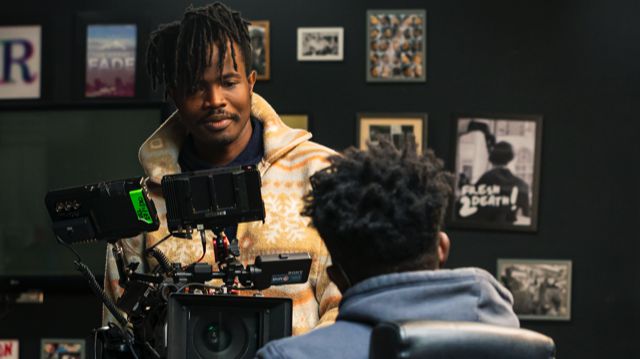
Which camera did you choose and what made it especially suitable for Love Languages? Likewise with your choice of lenses. What look were you aiming to achieve with them?
When it came to selecting the camera system for our project, I was initially pushing to shoot on ARRI cameras because I am a fan of their sensor and the way it captures beautiful skin tones. The ARRI sensor has a reputation for producing natural, organic and accurate skin tones, which is something that is crucial to me as a cinematographer. However, Jason was keen on achieving the highest image resolution possible, 4K, as it is a requirement for Netflix. Unfortunately, the only ARRI ALEXA cameras that had native 4K capture at the time were the Mini LF and the ALEXA 65, which were out of our budget for the project.
I had to consider other camera systems and I remembered my previous experience with Sony’s FX9, when it was first released. I was familiar with the sensor and how it compared to the SONY VENICE, and I was impressed by what I saw. The FX9 sensor was very similar to the VENICE and having several FX9s was a lot more budget-friendly than multiple ALEXA Mini LFs. While we could have used the Super35 crop on the Sony FX9, I opted to shoot Large Format and using Large Format lenses. Specifically, we used the Angénieux Type EZ 1 and a S35 Fujinon 19-90mm lens, which is a very versatile and beautiful Zoom lens I use a lot. For our contributor interviews, we used a set of Canon Sumires.
Shift4 rental house was able to provide us with a comprehensive and generous rental package that included three Sony FX9s, a set of Canon Sumires primes, Angénieux Type EZ 1 for FF/VistaVision and S35, and Fujinon Cabrio 19-90mm T2.9, for which we were very grateful. Despite the initial challenges, we were able to achieve our goal of a 4K capture while maintaining the beautiful skin tones I was looking for, thanks to the equipment provided by Shift4.
Tell us more about your intimate approach to framing and composition.
When it comes to my approach to lens selection, I am particularly drawn to the subjectivity that long lenses provide to an image. The compression effect that a long lens creates, blending the foreground into a painterly canvas of background bokeh, is something that I find particularly appealing. This approach became a win-win situation for our project because it allowed me to create the intimacy that was required, while at the same time creating a sense of expressionism and depth in the space.
During the contributor interviews, I typically shot just below the eye-line in order to elevate the speaker and give some heft to their words. This approach helped to create a sense of importance and emphasis on the subject’s words and emotions. Additionally, the use of a long lens helped to compress the space and blur the background, further emphasising the subject and their words.
Overall, my use of long lenses was a conscious decision, aimed at creating a sense of intimacy and expressionism in the space, allowing me to convey the emotions and ideas of the project with a strong visual language.
Furthermore, how did you aim to capture the sense of the barbershop being a safe space in your lensing?
Lighting played a crucial role in creating a feeling of a safe space for our project. I decided to lean into warm colours, largely through lighting, using tungsten bulbs and light sources. This helped to create a warm and inviting atmosphere and set the tone for the project.
It was also important that the light was soft and not too harsh, as harsh light can create an undesired sense of drama and intensity. To avoid this, I used soft shadows and diffused light sources, which helped to create a sense of intimacy and warmth.
As mentioned above, using longer lenses to compress the image and dissolve the background noise and distractions was another way to push a sense of intimacy between the contributors and the viewer. This helped to create a sense of closeness and connection between the subjects and the audience. The staging and framing of our group discussion was also an important consideration when it came to conveying the sense of safety and community among our contributors.
I made sure to have a camera capturing candid moments of them laughing, smiling and enjoying each other’s company, as this helped to create a feeling of positivity and connection among our subjects. Overall, lighting, lens choice, staging and framing were all key factors in creating a sense of safety and community in our project.
Let’s talk about lighting – what was your general approach to lighting the subjects?
The general approach for lighting was to have a soft, warm and controlled lighting setup. The goal was to minimize the use of floor lamps on the day of the shoot, with the exception of when shooting the interviews. We replaced the bulbs that lined the mirror in the barbershop with low wattage bulbs to prevent them from blowing out on camera, as we did not have dimming controls for them.
To motivate the light source from the bulbs, we lined the wall above the bulbs with an array of Litegear Litemats and covered them with a bed of unbleached muslin to break the digital look of LED light sources. Additional Litemats were fixed along the corners of the shop to provide backlight in every direction, which could be adjusted depending on the direction of the shot.
To create a base ambient light in the space, a 2k tungsten Jem Ball was rigged above the space where the group conversation took place and skirted with black Bolton to control the spill from hitting the walls. This was the broad stroke for the lighting setup. For the interviews, we accentuated the key with either a LiteMat or a Jem Ball and alternated the direction with each contributor, so that the lighting was dynamic and did not feel stale throughout the film.
What was your collaboration with gaffer Vini Curtis like and what did your lighting package consist of?
I have been working with Vini Curtis for several years, and we have a strong working relationship. He fully understands my lighting approach and sensibilities, and our shorthand is very strong. I usually give him a broad brief of what I am aiming to achieve, and he can fully flesh it out.
While I prefer to shoot with tungsten light sources, we both understand the practicality and flexibility that LED light sources provide. For this project, we decided to mix tungsten and LED light sources to achieve the desired look.
Our LED lighting package consisted of an 8×8 LiteGear LiteTile, a LiteMat 4 Spectrum, and a Litemat 3 Spectrum. We also included some Astera NYX bulbs. Our tungsten package included a 2k Jem Ball, 2 Source4, and a KFlect kit which I use with Dedos to create small pools of light and power windows. This combination of light sources gave us the flexibility to achieve the desired look and feel for the project.
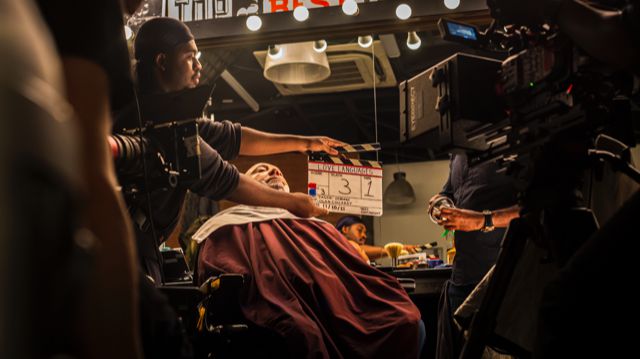
Tell us more about the production’s collaborative approach to the beautiful colour palette.
The colour palette for the project was something that the entire team, including the director and production designer, discussed and carefully considered. We knew that the dark walls of the shop would provide a black canvas to build on, and so we decided to incorporate warm, earthy tones such as reds, oranges, and browns into the scene. These colours worked well with the skin tones of our subjects and helped to create a warm and inviting atmosphere.
The warm lighting helped to blend all the tones together into a cohesive palette. This, combined with the use of an in-camera LUT, allowed us to create a distinct and cohesive look on set, rather than trying to find it in post or during the grade. Overall, the colour palette and lighting were carefully crafted to create a warm, inviting and cohesive atmosphere that evokes feelings of comfort and a safe space.
Who did the grade and what was their brief?
The grade for the project was done by another one of my long-time collaborators, Jonny Tully at CHEAT. Jonny is one of a very select few colourists I trust to take my work and bring it to the next level without much brief or supervision. For this project, it was important to me to highlight the contributions of our subjects and do justice to their skin tones. That’s why I knew that Jonny, who is known for his expertise in making darker skin tones shine, was the perfect choice to do the grade.
The image we captured on the day was very warm, as per our initial intention. However, after watching the first draft, I felt that we needed to dial back the warmth slightly to create some colour separation in the image. By introducing some cooler shadows, we were able to complement the warm skin tones and create a more dynamic and visually striking image. Jonny’s expertise and attention to detail in the colour grading process helped us to achieve the desired look and feel for the project.
What was your favourite memory from the production process?
One of the most memorable and meaningful moments of the production process was listening to the powerful and courageous stories of our contributors. These stories reminded me of the importance of the work we do in the film industry, and how we can honour and tell the stories of others. These stories have the power to provide a guiding light of hope to others and help shape their perceptions of important issues. Hearing how these stories were received and how they impacted the way viewers understand and perceive love within their communities was extremely affirming. It was a humbling experience to be a part of a project that had the ability to touch people’s lives in such a meaningful way. It was a reminder of the power of storytelling and the impact it can have on shaping societal attitudes and understanding. The process of capturing these stories was an extremely rewarding experience, one that will stay with me long after the project is complete.
What role do programmes such as Netflix’s Documentary Talent Fund play in supporting the work you do?
The Netflix Documentary Talent Fund provides a unique opportunity for filmmakers to tell important and underrepresented stories about their communities. These are the stories that often go overlooked by mainstream media and funding bodies, due to a lack of data to support their potential viewership. But with the support of this fund, filmmakers can break that cycle and create powerful and meaningful films that speak to underrepresented communities.
As a cinematographer, this is an opportunity to work on stories that align with my values and personal vision. To collaborate with like-minded filmmakers who are passionate about making a difference through their work. It’s an opportunity to use my gift to create emotive and evocative images that bring these stories to life in a new and powerful way.
The fund allows me to push the boundaries of what’s possible and to create films that not only entertain, but also inspire and educate. It’s an opportunity to be a part of something bigger than myself, to help change the world and culture through my work. I believe that this fund can open new doors for filmmakers, and I am honoured to be a part of it.




